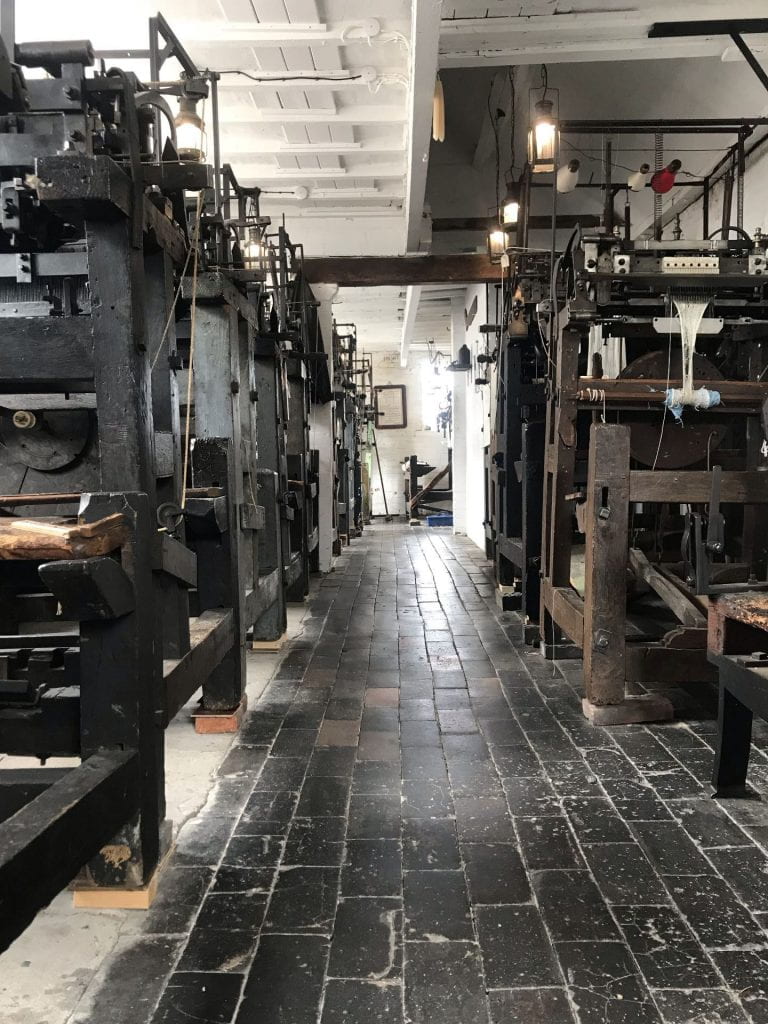Knitting in Nottingham: Hands-on Experience with Historic Knitting Frames

Manually converting knit stitches to purl stitches with a tiny hook on an operational knitting frame this summer at the Framework Knitters Museum in Nottingham, UK.
By Emily Whitted, WPAMC Class of 2020
An aspect of my thesis that I’m researching while at Winterthur focuses on a little-understood textile technology: the knitting frame. Also called the stocking loom (although this term would suggest both that the frame functions like a loom and that stockings made on them are woven, which are both incorrect), the knitting frame dates back to the 16th century and was originally invented in England. Using thin but strong hooked needles, a series of wooden pedals, and a complex carriage made of among many other parts, springs and small sheets of curved metal called jack sinkers, the knitting frame is able to produce flat knitted fabric that can be shaped to create a stocking. On average, a skilled frame knitter could produce a stocking and a half per day.

Two long rows of knitting frames on the top floor of the main workhouse at the Framework Knitters Museum.
From what little is written about knitting frame technology, it was almost immediately clear to me that diagrams alone would not be able to successfully convey the actual motion of a frame knitter at work on his knitting frame. I knew I needed to try to operate one in person. While there are knitting frames in collections in America, none of them are currently operational. However, I looked back to the country who first created them and found the Framework Knitters Museum just outside of Nottingham, England. The Framework Knitters Museum is devoted to preserving and maintaining historic knitting frames, as well as telling the story of the massive knit stocking industry happening in and around Nottingham until well into the 20th century. With assistance from the Center for Material Culture Studies at the University of Delaware, I was able to visit the Framework Knitters Museum and learn to operate an early 19th century English knitting frame. Jim Grevatte, the director of the museum, and Matthew Hamilton, their Framework Coordinator, were my gracious hosts. During my time there I was able to produce some stocking gauge cotton knit fabric, with a small pattern that could have been found in historic stockings of the period to mimic traditional embroidery around the ankle, called clocking.
I learned a great deal just by putting my body through the motions of operating a knitting frame. Both the arms and legs are engaged in rhythm when knitting on a frame, but rhythm stops when repairs are needed, whether to the machine itself or to the fabric on the needles. Before attachments for ribbing were invented and could be added to standard frames, purling stitches to create patterns or texture needed to be done by hand by unpicking and reversing the knit stitch with a thin hooked needle. The stooped posture I assumed as I hunched over the machine, unpicking and reversing stitches, soon had my shoulders aching. The stitches are also incredibly fine, so even in broad daylight with 20/20 vision, I was struggling to see the work I was doing. Given that experience, it was unsurprising to me that frame knitters frequently lost their eyesight. To bring more light into the workplace, frame knitters would fill glass balls with water and iron filament, which would turn the water blue and reflect the sunlight. I also became painfully aware of the importance of a comfortable seat; frame knitters frequently customized their wooden seats with leather straps which would mold to them, and if for any reason the knitter needed to switch frames, he would take his seat with him.

A typical tool to magnify the light in a frameknitter’s workshop, a glass orb filled with water and iron filament.
Thanks to this first-hand experience of operating a knitting frame, I am much better able to analyze historic knitting frames in collections and identify signs of use. There is a 1752 knitting frame within the Paley Design Center’s collection at Jefferson University in Philadelphia that was used in Germantown, PA to make stockings, and it has a wealth of clues that allow me to better understand its use and relationship to the body of the man who operated it. Foot rests were cut onto the back rail of the frame to provide slightly more comfort for the user as he stopped for repairs, and a series of roman numerals are cut into various plates and wooden screws to keep track of which parts went where in case they needed to be removed for more significant repairs.
Without this hands-on experience, I truly might not have known what I was looking at when studying these complex objects.


How wonderful. I live in Nottingham and my 3x and 4x Great Grandfathers were both framework knitters. 4x Great Grandad we have a record of him being treated for arthritis in his early 30s, and this resonated with your descriptions of the physical nature of the work.
How interesting!! I am a sock knitter and was amazed at your article. I never knew there was such a machine. How fortunate for you that you got to see it and use it as well. Thank you for sharing.